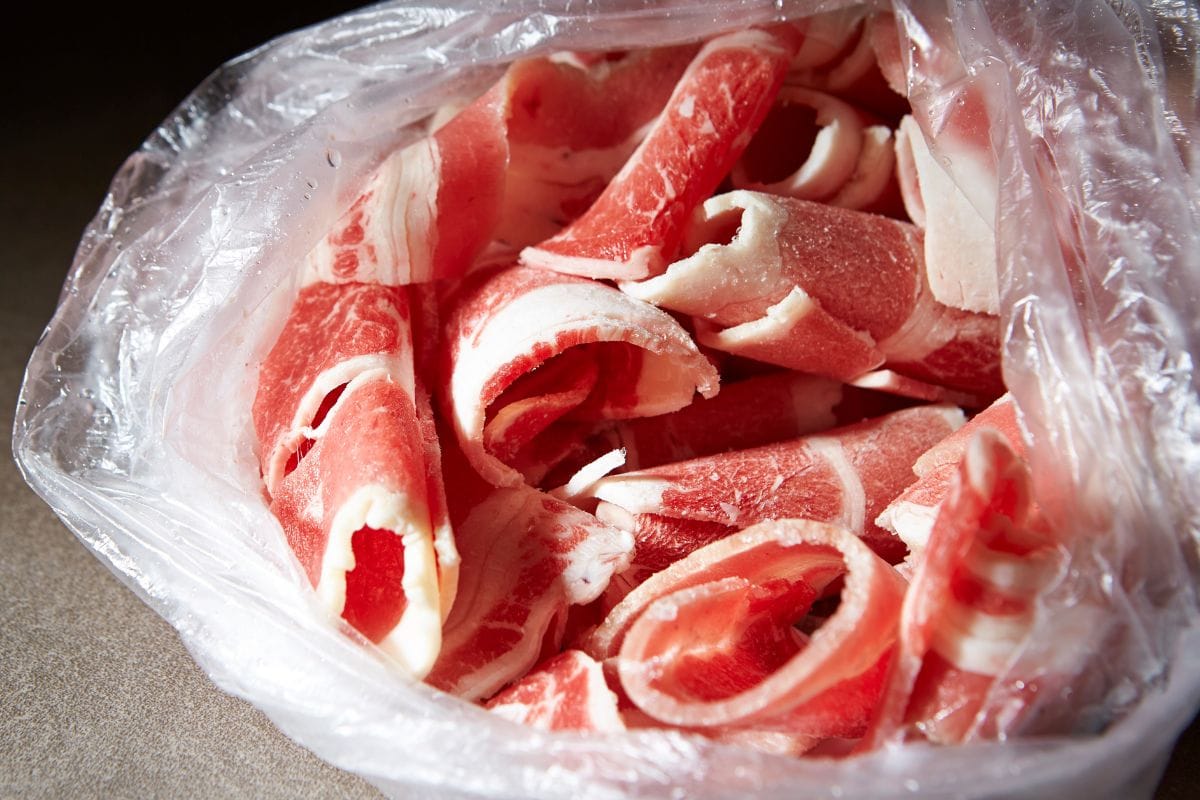You can tell if your ham is bad by looking at it, feeling the texture, or smelling it. A rotten smell, slimy texture, discoloration, and mold are common signs that your ham may be rotten.
Ham can go bad quickly under the wrong conditions. As a result, knowing the difference between a bad ham and a fresh one is crucial since it affects your health and the flavor of your dishes.
As an experienced chef, I’ve cooked ham for many years, and I’ve learned how to distinguish fresh hams from bad ones. Today, I’ll highlight my tried and tested ways to tell if the ham is spoiled and show you the best ways to store it. So, without further ado, let’s begin.

There are a few quick and easy ways to identify spoiled ham. Let’s look at five signs to look out for if your ham is rotten.
Pay attention to the dates listed under “use by” on the meat package. If the ham’s expiration date has passed, the best step would be to throw the meat out. Don’t tempt fate by eating expired ham. You may end up getting seriously sick.
Ham should feel supple and have a slightly moist texture. If the meat has a slimy or sticky texture, it would be better to throw it out. Sliminess indicates that bacteria is spreading all over the meat. So, avoid any ham that doesn’t feel right when you touch it.
A slimy texture is especially noticeable on sliced ham. However, the sticky texture may not be as obvious on honey glazed ham. So, check other signs to confirm the whole ham is rotten.
A sour smell is a surefire way to tell if the ham is bad. Rotten ham emits a sulfurous odor that is detectable as soon as you open the pack. So, if you perceive any weird ham smells, I recommend disregarding the spoiled ham.
Ham can remain pink even after being thoroughly cooked. Fully-cooked ham has a similar shade of pink to that of fresh uncooked ham. Uncured ham will be a paler pink shade that almost looks beige.
If your half ham slices are showing unusual colors other than hues of pink, they may be going bad. Tones such as brown, gray, green, black, or green are unusual. So, pay attention to any discoloration and throw the meat out if you notice any.
Related Reading
Mold isn’t something you want to see on your ham. Bacteria grow with mold, so you risk getting sick from eating or even sniffing meat with mold. If the ham has a spot of mold, dispose of it carefully so the mold spores don’t spread through the air and infect other people.
Expert Tip: Bear in mind that some ham varieties, such as country ham, may have an unpleasant odor. Moreover, mold may grow on the surface of the country ham due to the curing process. This unpleasant smell and mold don’t always indicate the meat is bad.
So, you’ll need to investigate the meat a bit further to be certain it’s perfectly fine. For instance, check the texture and look for any unnatural colors. The US Department of Agriculture Food Safety advises rinsing the country ham with mold under hot water and using a firm scrub to scrape it out.

Ham typically lasts for 3–5 days in the refrigerator. Your ham will probably be spoiled after five days. So, you should throw it away. On the other hand, canned ham can last for up to 2 years. However, once it is opened, you have the customary 3–5 days.
You can also freeze ham so it lasts longer. Frozen ham will typically last 1-2 months before going bad. If the packaged ham is unopened, simply place it as is in the freezer. However, if the ham is already opened, wrap it tightly in plastic wrap or aluminum foil and place it in a freezer bag. Remove all the air from the bag, then seal it before placing it in the freezer.
Note that cooked or cured ham will keep for 3 to 4 months, while uncured or uncooked ham can last for up to 6 months.
Expert Tip: If you have a vacuum sealer, try sealing cured ham in plastic rather than leaving it wrapped in a freezer bag. Doing this will remove air from the package and make the meat last longer. Put the cured ham inside the vacuum-sealing bag and place the bag in the sealer. Then, put the pack in the freezer and consume it within the following four months.
After storing your tasty log of ham in the fridge or freezer, it’s important to know how to thaw it so you get the best quality ham. Here, I’ll show you three of the best ways to thaw ham:
Thawing ham in cold water always works in an emergency. In order to stop thawing water from penetrating the flesh, you should tightly cover the meat. This way, the ham’s flavor will remain intact. Remember to periodically check if the meat has softened. Also, ensure you change the water every 30 minutes to maintain a constant temperature.
Thawing in the fridge is a good way to slowly defrost ham. However, ensure the temperature is not below 40°F. Personally, I recommend thawing ham in the fridge because you don’t need to regularly check it like the other methods on the list. Simply leave the meat in the fridge for 12–24 hours before cooking. Place the meat in a tray to trap water so your fridge doesn’t end up looking messy.
Using a microwave is another way to thaw ham. However, this method may lead to unexpected results if you aren’t careful. When meat is thawed in the microwave, it may cook unevenly, especially if the meat is a whole ham. The inside may still be raw while the skin is already cooked and dry.
The best way to reduce these complications is to use the thawing/defrost mode on the microwave. Moreover, carefully study the manufacturer’s directions on the label to determine the appropriate thawing time.
Related Reading

You can keep ham fresh using different methods. Let’s discuss the three most common ways to keep this tasty pork cut fresh.
Refrigeration is a good way to keep ham fresh as long as you plan on cooking it soon. For the most effective results, your refrigerator should be kept at 40 degrees or lower. Ham can last in the fridge for up to one week prior to cooking.
Bear in mind that ham should be carefully wrapped in aluminum foil or plastic and placed in the refrigerator to extend its shelf life. Lay the foil, paper, or plastic wrap out on the counter, place the ham in the middle, and then tightly fold the material over the ham in overlapping layers. Then, put the ham in the refrigerator right away.
For bigger pieces of ham, place them in an airtight freezer bag or container. This will prevent the ham from going bad and help it retain moisture. In case your bags or containers aren’t big enough, simply cut the cooked ham into smaller pieces.
If your refrigerator isn’t big enough, you can put the whole ham in a cooler with ice in it. Remember that you must replace the ice once it melts to keep the ham fresh. Moreover, you need to place a thermometer inside the cooler to read the temperature.
Once the temperature rises above 40 degrees, it’s time to add more ice or place the meat in the freezer. Also, keep raw and cooked meat separate when storing them in a cooler to prevent the spread of bacteria.
If you’re a big fan of ham, it’s smart to buy it in bulk and store it in a freezer rather than visiting the grocery store often. The low temperature in the freezer increases the meat’s shelf life and ensures it stays fresh for longer. However, note that although there is no risk in keeping ham in the freezer for long, it may lose its freshness over time as it picks up flavors from other foods in the freezer, dries up, and develops freezer burn.
First, you must check to make sure the ham is still edible (the tips I highlighted above will help here). Prepare your oven to 135–140°F and reheat the meat till it reaches 145 degrees. Then, remove it from the oven and serve.

Bad ham will have an unpleasant odor, spots of discoloration, mold, and a slimy feel. So, if you see any or all of these signs on your ham, it’s best to throw the meat away. Follow my storage tips so your ham lasts longer. These tips will save you some money and effort. So, share them with your friends and family and continue enjoying this delicious pork cut.